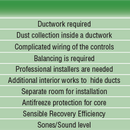Ductless Regenerator HRV/ERV
An affordable ERV became available at Home Depot about 5 years ago, and I believe it is the best choice for any home.
https://www.homedepot.com/p/VENTS-US-Single-Room-Energy-Recovery-Ventilator-Expert-Series-TwinFreshExpert/309579804
https://vents-us.com/cat/762/
There are no ducts, so there is very little to screw up.
I’ve attached their comparison to a conventional HRV/ERV.
My question is, why hasn’t this style of heat recovery disrupted the market and put everyone else out of business?
GBA Detail Library
A collection of one thousand construction details organized by climate and house part










Replies
Why do you think it is a superior choice?
Your words make you sound like maybe you work for the manufacturer?
Haha sorry, it does sound like I work for the manufacturer. I'm a retired engineer building a couple of spec zero energy rental homes per year.
I didn't want to spend a lot of time explaining the differences, just look at the matrix. Can you see it OK?
Those are a lot like the Lunos HRVs (https://foursevenfive.com/lunos-e/) that have been covered on this site. To my understanding the disadvantages are:
(1) Low flow, so you may need a lot of them for a whole house.
(2) Poor latent recovery (hence why the Lunos product is called an HRV rather than ERV).
(3) Real-world efficiencies nearer to 50% due to wind being able to overpower them.
I got that last figure from the BS and Beer show (probably this episode: https://www.youtube.com/watch?v=tvFylYqP07Y, but I haven't looked to be sure).
Anyway, I got the Lunos for an attic renovation before I saw that BS and Beer show. But I don't think I'll regret it because ducts would have been a problem. I haven't actually gotten around to installing them yet, so can't comment on personal experience right now.
Looks a alot like Lunos' solution. I would add to Paul's list:
1. Point of use air mixing, so might require even more units per house.
2. Lots of penetrations in the building shell - more potential for air and water leaks
3. More wiring for all of those units.
4. Potentially much higher costs for whole-house solution
At least one advantage could be individual controls based on individual zone requirements, if set up with smart sensors and controls, with potential energy and comfort improvements. Could get complicated.
It seems that HRV and ERV's are much more popular in Europe and Asia. There seem to be a lot more versions and the costs are lower.
For instance the Vtronic VT501 are around $150 on Alibaba.
Hopefully these become available in the US soon!!
You forgot to add $1000 for the lawyers in the U S.
Thanks Jay!
Conventional HRV systems cost $3k to $8k and aren't cost effective except in very cold climates.
Read https://www.greenbuildingadvisor.com/article/are-hrvs-cost-effective.
Therefore, bath fans are often used to meet ASHRAE 62.2 when that is required by the AHJ.
The Vtronic at a price similar to a bath fan is very cost effective.
Besides cost, perhaps the best thing about a regenerator is the lack of freeze trouble.
The unit you linked to is the single fan unit. For these to work well (or to have some reasonable efficiency) you need two of them with the units linked to operate in opposite direction. Having to buy two at $530 is not what I would call cheap. That is above the cost of an ERV.
Their TwinFesh DUO is a better setup as it has two fans and can provide regeneration in a single unit. I can't find a price on this unit though.
My big beef with these is that the fans are axial which have very a very shallow flow/pressure curve. It doesn't take much wind or even stack effect to significantly change the flow through them.
My goto for budget and small place is the Pansonic whispergreen ERV. This has proper blowers, inexpensive and pretty close to standard hookup for trades. The only drawback of it is that is goes to exhaust only mode in cold weather.
That looks like just about the worst ERV I could imagine. Features like no ducts and not needing a separate room only matter if the device does an equivalent job. These things don't even come close. You'd need about 16 of those things to provide enough ventilation as decent sized ERV. There goes any savings or labour saving. The efficiency would be horrible. The separate room they're whinging about is generally part of any home already, called the utility room. The reason they haven't disrupted the market or put anyone out of business is that they're junk.
Trevor, you don't need 16. Most homes only need 45-75 CFM continuous*. Your range hood and bath fans provide the rest of fresh air requirements. It doesn't make sense to size the HRV for those loads because they aren't continuous.
But the VentUS is getting a crappy reputation and Home Depot just discontinued this unit.
That leaves Lunos https://foursevenfive.com/blog/introduction-to-the-lunos-heat-recovery-system/
Lunos is still very pricey.
Panasonic WhisperComfort is a nice economical unit but worthless (exhaust only) when it's cold out, and that's when you want your ERV to be working.
Does anyone have a good strategy for this and what is a typical installed cost?
I think we're headed where a lot of these discussions head:
The heat provided by a minisplit heat pump that is powered by solar on the roof is cheaper per BTU, and the installed equipment cost is also cheaper than the heat recovery equipment.
So if building codes start to require heat recovery, I think we should push back.
*https://homes.lbl.gov/ventilate-right/step-3-whole-building-ventilation-rate
I just found another thread on the topic:
https://www.greenbuildingadvisor.com/question/northern-climate-hrv-recommendations
I remain a cheerleader for regenerators. They are 90% efficient vs. 60-70% for a crossflow heat exchanger.
The issue that drove me to choose a central system instead of distributed regenerators was the desire to filter the incoming air, as many of my neighbors heat with wood and the air can be unbearable and unhealthy on some days.